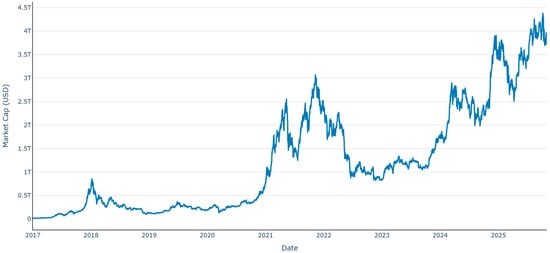- Article
Integrating High-Dimensional Technical Indicators into Machine Learning Models for Predicting Cryptocurrency Price Movements and Trading Performance: Evidence from Bitcoin, Ethereum, and Ripple
- Rza Hasanli and
- Mahir Dursun
The rapid evolution of digital assets transforms cryptocurrencies into one of the most volatile and data-rich financial markets. Their nonlinear and unpredictable nature limits the effectiveness of traditional forecasting models, motivating the use of machine learning methods to identify hidden patterns and short-term price movements. This study compares the performance of Logistic Regression (LR), Random Forest (RF), XGBoost, Support Vector Classifier (SVC), K-Nearest Neighbors (KNNs), Long Short-Term Memory (LSTM), and Gated Recurrent Unit (GRU) models in predicting the daily price directions of Bitcoin (BTC), Ethereum (ETH), and Ripple (XRP). Extensive data preprocessing and feature engineering are performed, integrating a broad set of technical indicators to enhance model generalization and capture temporal market dynamics. The results show that XGBoost achieves the highest classification accuracy of 55.9% for BTC and 53.8% for XRP, while LR provides the best result for Ethereum with an accuracy of 54.4%. In trading simulations, XGBoost achieves the strongest performance, generating a cumulative return of 141.4% with a Sharpe ratio of 1.78 for Bitcoin and 246.6% with a Sharpe ratio of 1.59 for Ripple, whereas LSTM delivers the best results for Ethereum with a 138.2% return and a Sharpe ratio of 1.05. Compared to recent studies, the proposed approach attains slightly higher accuracy, while demonstrating stronger robustness and profitability in practical backtesting. Overall, the findings confirm that through rigorous preprocessing machine learning-based strategies can effectively capture short-term price movements and outperform the conventional buy-and-hold benchmark, even under a simple rule-based trading framework.
18 December 2025




![Radar Chart of the Composite Variables [19]. Source: Author’s own compilation based on SPSS output and the 2022 survey data. The visualization was prepared with technical assistance from OpenAI ChatGPT 5.0 [20].](https://mdpi-res.com/fintech/fintech-04-00075/article_deploy/html/images/fintech-04-00075-g001-550.jpg)
![Systematic Literature Review Process [21].](https://mdpi-res.com/fintech/fintech-04-00074/article_deploy/html/images/fintech-04-00074-g001-550.jpg)

